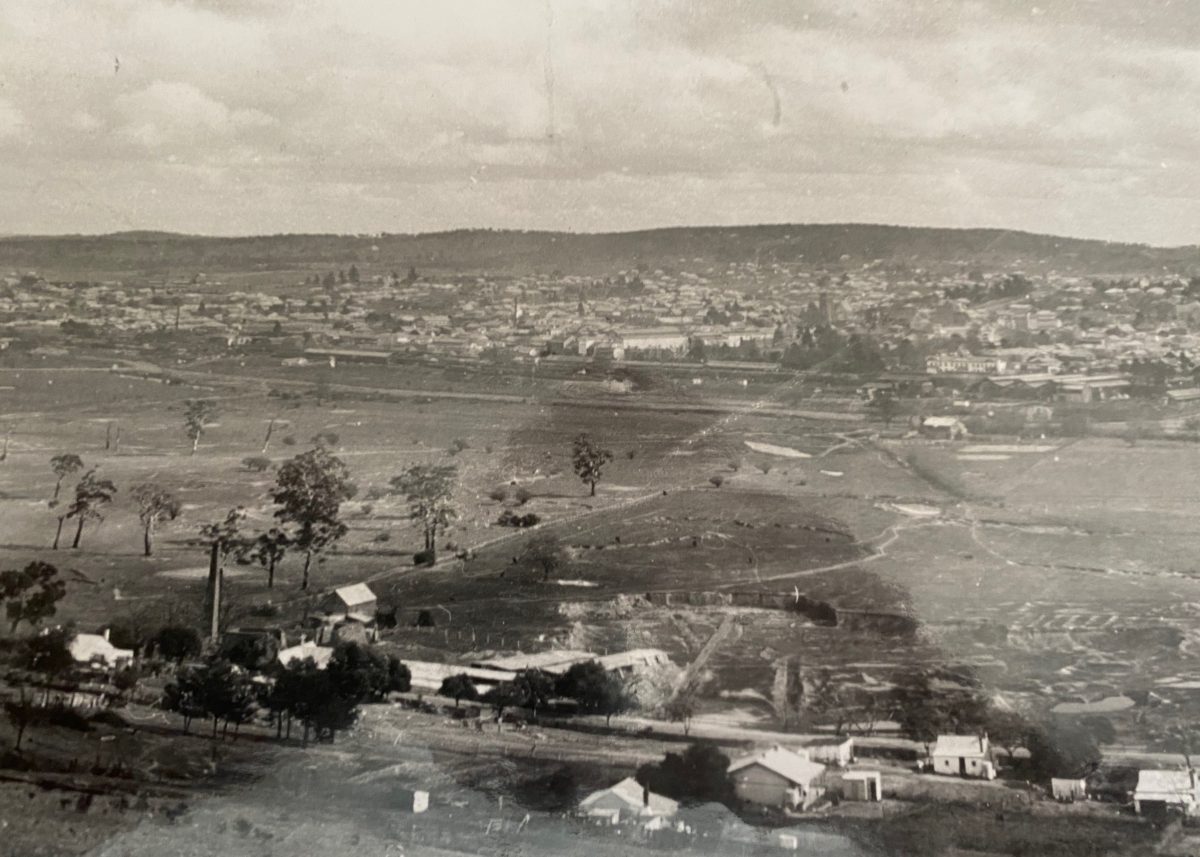
Engaged to be married to Valmai Hill in 1951, Eric Hunt making bricks for their new home. They married the following year. Photo: Hunt family collection.
It was a time of devastating floods sweeping homes and livestock from the river valleys through Goulburn, of the railway arriving in the city, brick-making galore and a little patch of homes becoming Irish town.
The floods and railway’s arrival are well recorded, but not the Irish community that left its name tacked on to the edge of Eastgrove. Older generations in Goulburn remember Irish town from what their parents or grandparents told them. Some recall the Irish worked in the brick pits, and some lived in tents and were employed building the railway line and viaducts.
Historian Linda Cooper found a reference to Irish town from 14 June, 1856, in the Bathurst Free Press and Mining Journal about railway surveyors having reached Goulburn and discussing the direction of the line, progressing through the brick pits or ”Irish Town”.
Linda and fellow historian Heather West believe the Irish settlement was around three Eastgrove streets running off May Street: East, Henry and Chiswick streets.
Retired butcher Roger Doughty remembers being sent to East Street to live with his grandparents, Mark and Olive Bush, who called it Irish town. About two years old at the time, Roger had been living in Opal Street when an older boy next door contracted scarlet fever in 1943.
“Mum and Dad didn’t want to risk me getting it, so they shoved me off over to Eastgrove,” he said.
He was there for about six months.
Roger recalls the McDonald and O’Neill families in East Street. In Henry Street, he remembers two or three homes and the Cowlings.
Now 93, auctioneer and Shetland pony breeder Eric Hunt said Irish town was famous for him and his childhood mates.
“We used to play up and down that street (Henry Street), there wasn’t a heap of cars in those days, doing all the things kids get up to.”

Thomas Stubbins’ brickworks can be seen at the left of this photo, with a kiln chimney rising near the boundary of what today is the Goulburn Golf Course. The homes in the foreground are thought to be the area known as Irish town. Photo: Jeff Coggan collection.
Their mischief included raiding Tom Stubbins’ carrots and turnips paddock.
“He was a good bloke, he knew we were doing it,” he said.
“Tom was a good mate of my father’s [Robert] and he wanted him to build a trough of bricks from the river along the golf links fence, and up towards the end of the trough was where he grew turnips.”
In later years, Eric’s brother-in-law John Hill bought the paddock and the family grazed their ponies and cattle there. It’s now part of the Goulburn Wetlands.
Eric remembers playing with a Ray Elwyn who lived there, and the McDonalds.
In adulthood, Eric and his wife Valmai scrambled during floods to shift their horses, stranded between wetlands and the Mulwaree Chain of Ponds, sometimes at great risk. Swimming across a swollen pool in one flood, Eric became entangled in a prickly snarl of blackberry bush.
About 1988, he took a boat to rescue stranded ponies in Stubbins paddock, and Valmai took their two-year-old grandson David with her to a different section of the stud to rescue a filly, before going over to Stubbins gate.
“David ran across the road, jumped up on the gate and all he had on was a singlet and nappy,” Valmai said. “He’s on the gate screaming out to the horses, ‘Gee-gee, gee-gee’. The photographer from the Evening Post happened to come along at that time and took this photo of David standing up on the gate with his nappy around his knees and his bottom showing. On the front page of next day’s paper was his photo under a heading, ‘Who needs nappies?”’
Opposite the three streets and running parallel with May Street were the brick pits owned by Thomas Stubbins. Beginning in 1869, they were named the Melbourne Place Brickworks and operated until the 1930s. Full of water these days, they are the Goulburn Wetlands.

Labourers preparing formwork and bricks for the Mulwaree Ponds viaduct, built between 1913 and 1914. Seventy-five men were employed, and the bricks, oddly enough, came from the State Brickworks in Sydney rather than Goulburn. Photo: Jeff Coggan collection.
Jeff Coggan, whose father Harry established market gardens on the river flats, said that in the late 1800s, 22 brick pits were operating around Mulwaree Ponds. All the pits would have needed labourers, and it is likely many of these were Irish. The Fitzroy pit, for example, employed 22 hands.
During construction of Goulburn Jail from 1881-84, 4.5 million bricks were made. Labourers would have found plenty of work on the railway viaducts as well. They have long left, but Irish town remains a distant memory.







